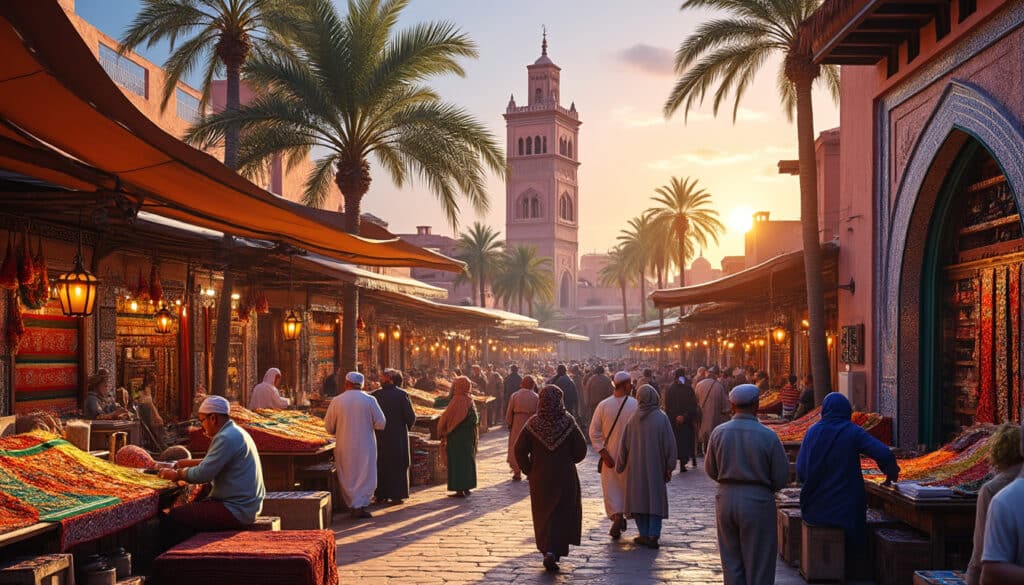Marrakesh, a city steeped in history and vibrant culture, is a tapestry of visual and symbolic elements that resonate with both locals and visitors alike. Known as the “Red City,” Marrakesh is an enchanting fusion of ancient traditions and modern influences. Among its many symbols, the Moroccan national flag plays a significant role in expressing the identity of Marrakesh and Morocco as a whole. This flag, with its striking red background and emblematic green pentagram, is more than just a national symbol—it reflects the enduring spirit and cultural heritage that define this remarkable city.
The Historical Significance of Marrakesh’s Names and Symbols
Marrakesh, with its rich history dating back nearly a millennium, has been known by several names throughout its existence. Each name reflects a different era and influence on the city, representing its evolving identity. The original Berber name, “Amur n’Kush,” meaning “Land of God,” speaks to the deep spiritual roots of the city. As time progressed, the name transformed into Marrakesh, becoming synonymous with its colored landscapes and vibrant souks, highlighting its identity as a center for trade and artistic endeavors.
The city’s identity is not just encapsulated in its names but also in its symbols. The Moroccan flag, prominently displayed throughout Marrakesh, serves as a powerful emblem of national pride and unity. Its red background symbolizes strength and courage, vital characteristics of the Moroccan people who have endured various challenges throughout history. The green pentagram, representing the five pillars of Islam, underscores the city’s religious and cultural influences, essential elements in the lives of Marrakesh’s residents.

Marrakesh’s Role in Moroccan History
Marrakesh has played a pivotal role in Moroccan history as one of the four Imperial cities. Founded in 1062 by the Almoravid dynasty, its rich history is reflected in its architecture and urban features. This grand heritage is evident in landmarks such as the Koutoubia Mosque and the intricate beauty of the medina, now a UNESCO World Heritage site, which are prominent in Marrakesh’s cultural narrative.
During the Almohad and Saadian dynasties, the city grew into a political and cultural center. This growth was marked by the expansion of the city’s infrastructure and the flourishing of arts and culture, including the establishment of schools and mosques that still stand today. Each era left its mark, shaping Marrakesh into a city that embodies the composite nature of Moroccan heritage.
The Vibrancy of Marrakesh’s Flag and Cultural Events
The Moroccan national flag, a symbol proudly flown in Marrakesh, connects the city to the broader narratives of national identity and independence. The flag evokes a sense of pride during national holidays such as Independence Day and festivals that celebrate Marrakesh’s rich mosaic of traditions. These events, infused with music, dance, and traditional attire, breathe life into the city, exemplifying the enduring spirit captured by the flag.
Marrakesh also holds a significant place during the Moroccan National Day celebrations. The city transforms into a vibrant tapestry, adorned with flags that symbolize unity and diversity. The display of the Moroccan flag reaffirms Marrakesh’s role as a cultural bridge within Morocco, linking its diverse communities through shared traditions and aspirations for the future.
Festivals and Their Symbolic Meanings
Festivals in Marrakesh showcase its unique identity and blend of cultural influences. The International Film Festival, for example, attracts global attention, reflecting Marrakesh’s openness and artistic spirit. Traditional Berber music festivals highlight the city’s indigenous roots, while local souks and artisanal markets display the handiwork that echoes the essence of Moroccan heritage.
- 🕌 Mawlid An-Nabi: Celebrating the birth of the Prophet Muhammad with vibrant displays and spiritual gatherings.
- 🎥 Marrakesh International Film Festival: A highlight of the city’s cultural calendar, bringing international cinema to Moroccan screens.
- 🍂 Igoudar Traditional Festival: Showcasing indigenous Berber traditions through music, dance, and art.
The Evolution of Marrakesh’s Flag and Its Influence
The journey of Marrakesh’s flags through time reflects the changing political and cultural landscape. The current flag, reminiscent of its historical counterpart from 1367, remains a strong symbol of the city’s enduring legacy. This squarish red flag with its swallowtail and central circle of blue/white checkerboard is emblematic of a long tradition of artistic creativity and cultural exchange.
The evolution of these flags chronicles Marrakesh’s resilience and adaptability. During the colonial era, influences transformed symbols and heralded new designs, signifying the city’s response to changing governance. Today, the flag remains a constant reminder of Marrakesh’s historical roots and its status as a beacon of cultural sophistication.
Cultural Influence of the Moroccan Flag in Marrakesh
The Moroccan flag significantly influences the artistic expressions in Marrakesh, inspiring various creative domains. From graphic design projects highlighting its colors to fashion designs that lean on its symbolic patterns, the flag is a recurring motif in Marrakech’s Oasis Identity and design culture. This exploration is not only aesthetic but serves to preserve and perpetuate Morocco’s rich traditions and narratives.
Furthermore, architectural projects within the city integrate the geometric elegance of the flag, aligning with Marrakesh’s historical architecture. These elements reflect a connection to Morocco’s imperial and religious past, layered with the modern aspirations of Marrakech’s Marrakech Threads.
Understanding Marrakesh Through Its Linguistic and Cultural Identity
The names and symbols of Marrakesh carry layers of linguistic and cultural significance, intertwined with its identity as the “Red City.” Language and symbolism converge here, illustrating the fusion of Berber, Arab, and French influences. With a mix of languages spoken across the city, from Arabic and Darija to French, Marrakesh stands as a testament to Morocco’s diverse heritage.
The cultural identity of Marrakesh is further expressed through its architecture and urban features, where historical narratives are woven into the city’s very fabric. From the intricate designs of the Ben Youssef Madrasa to the vibrant stalls of the Marrakech Souk, the city celebrates its rich heritage daily.
Linguistic Evolution and Cultural Identity
The evolution of language in Marrakesh mirrors its historical and cultural transformations. As languages have shifted and blended, they’ve contributed to the city’s dynamic identity. The usage of French, introduced during colonial times, continues to influence modern communications, while Darija connects Marrakshis to their Arabic roots.
- 🗣️ Arabic and Darija: Essential languages reflecting Marrakesh’s traditional roots.
- 📚 French Influence: Marking its colonial history and modern-day societal interactions.
- 🏺 Berber Languages: Indigenous languages preserving the core identity of early Marrakshis.
These elements intertwine to form a rich cultural mosaic, celebrated in Marrakesh’s daily life and major events alike.
If you’re eager to explore more about the vibrant city of Marrakesh, from its historical background to insightful traveler tips, the Marrakech Oasis guide provides extensive resources for a deeper understanding. Whether diving into the enchanting Marrakesh Architecture and Urban Features, or exploring the culinary delights with a unique Sahara Essence, every aspect of Marrakesh is a vibrant thread in Morocco’s grand tapestry.
FAQ
- What are the main colors used in the Marrakesh flag? The main colors are a deep red background with designs incorporating blue and white checkerboard patterns.
- Can visitors purchase artworks inspired by the Moroccan flag in Marrakesh? Yes, local marketplaces and art galleries frequently showcase and sell flag-inspired art pieces.
- How has the historical context of Marrakesh influenced its architectural style? Marrakesh’s architecture reflects a blend of Islamic, Berber, and Moorish styles, influenced by various dynastic periods and colonial history.
- What is the significance of the green pentagram on the Moroccan national flag? The green pentagram signifies the Five Pillars of Islam, underscoring religious tradition and cultural unity.
- Are there any annual events in Marrakesh that highlight the city’s historical and cultural narrative? Events like the Marrakesh International Film Festival and the Igoudar Traditional Festival celebrate the city’s artistic and cultural heritage.

Fun Facts & Curiosities About Marrakesh
Marrakech, the enchanting “Red City” of Morocco, is like a multifaceted jewel that gleams under the North African sun. With its rich history, colorful culture, and architectural marvels, the city is a place where the past and present coexist in…

Architecture and urban features of Marrakesh
Marrakesh, a city bursting with energy and colors, serves as a monumental reflection of centuries of history and blending of cultures. Known for its unique architecture, Marrakesh embodies a fusion of Islamic, Berber, and French colonial styles that delightfully merge…
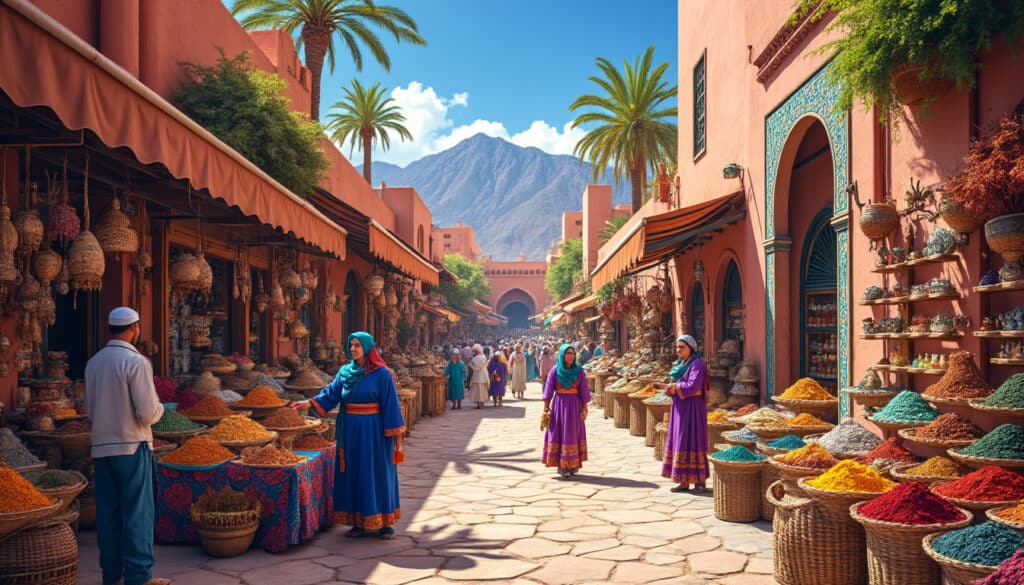
Nestled in the shadow of the magnificent Atlas Mountains, Marrakesh offers a vibrant tapestry of life that weaves together history, culture, and a thriving modern scene. Its bustling streets, scented with the aroma of spices and the buzz of local…
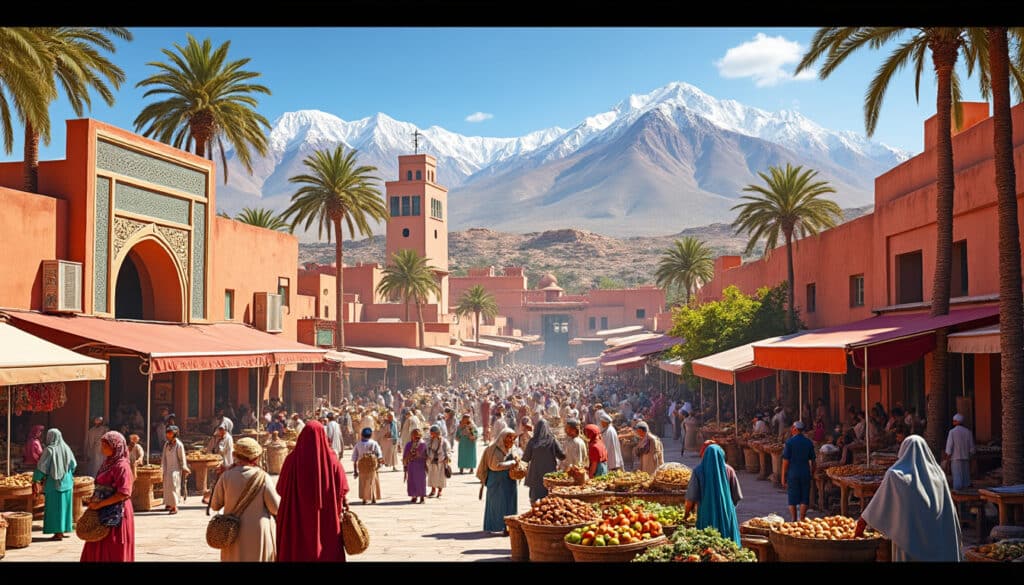
Demographics and geography of Marrakesh
Marrakesh is one of the most vibrant cities in Morocco, a hub of culture, history, and geographical diversity. Located at the foothills of the Atlas Mountains, this city boasts a unique blend of traditional and modern influences that reflect in…

Holidays and celebrations in Marrakesh
Immerse yourself in the vibrant tapestry of Marrakesh, a city brimming with an extraordinary array of holidays and celebrations. From the bustling souks to historic landmarks like the Koutoubia Mosque and the enchanting Majorelle Garden, Marrakesh offers a captivating backdrop…
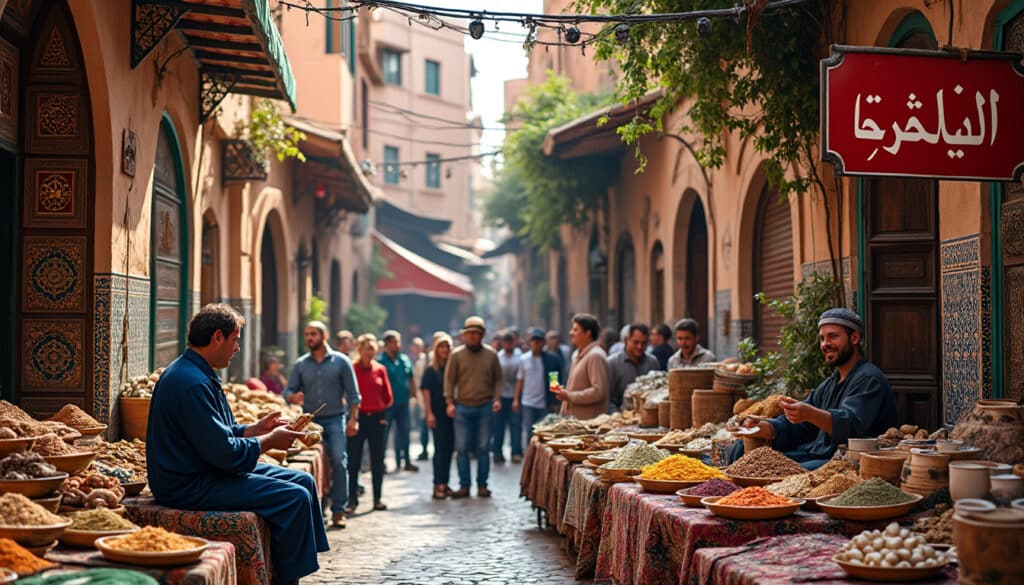
Language and spelling of Marrakesh
The city of Marrakesh, often also spelled as Marrakech, is more than just a destination known for its vibrant souks and stunning palaces. It’s a melting pot of cultures, languages, and history that reflect the dynamic interplay of evolution and…
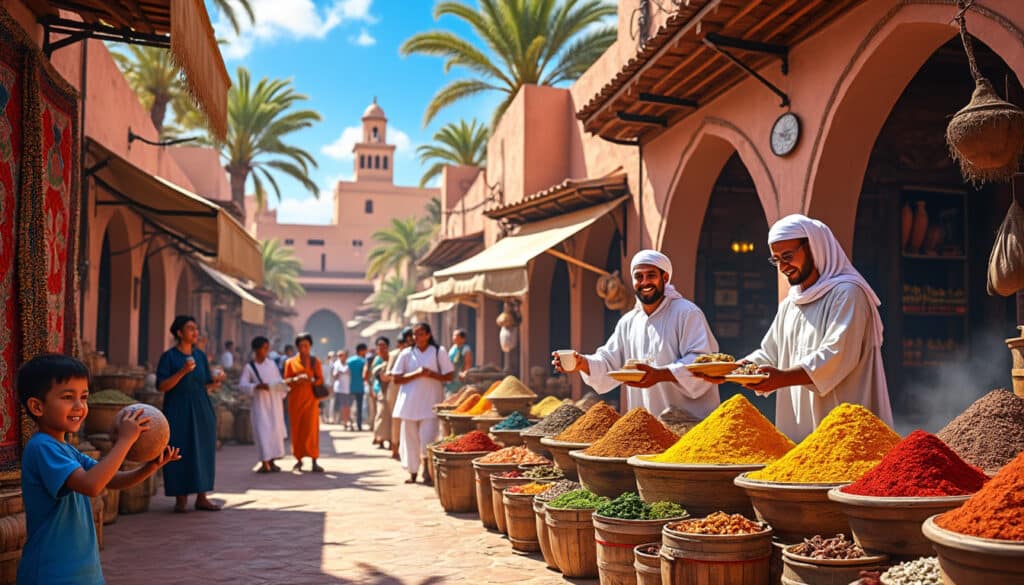
Local tips for tourists in Marrakesh
Marrakech, the captivating heart of Morocco, enchants visitors with its vibrant souks, stunning palaces, and aromatic cuisine. Known as the “Red City” due to its distinctive ocher walls, Marrakech offers a whirlwind of sensory delights that can both overwhelm and…
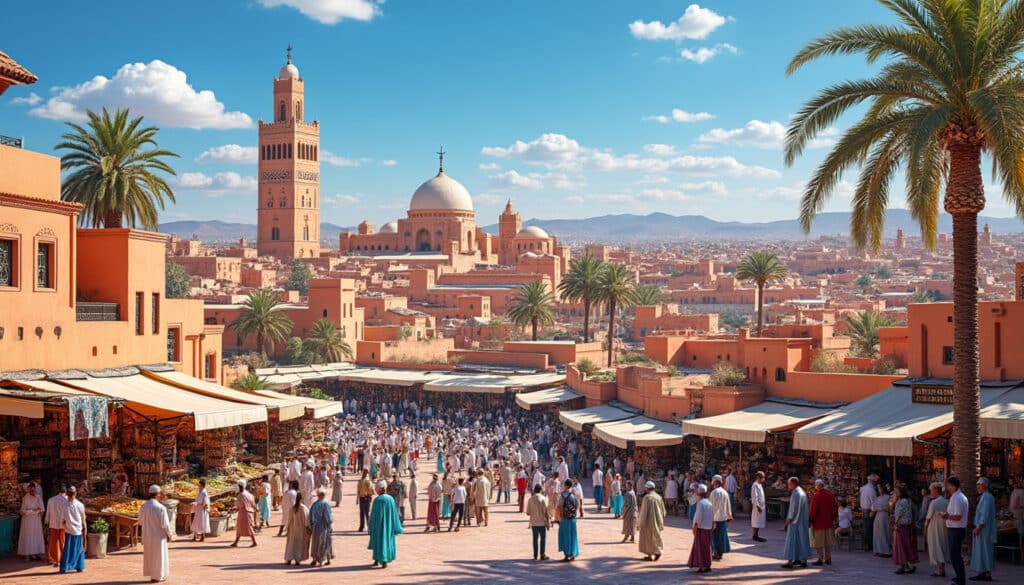
Reputation and identity of Marrakesh
Marrakesh, the “Red City” of Morocco, is a symphony of history, culture, and sensory experiences, where ancient traditions and modern lifestyles coexist beautifully. The city, with its vibrant marketplaces and iconic landmarks, offers a fascinating insight into Moroccan life. Each…
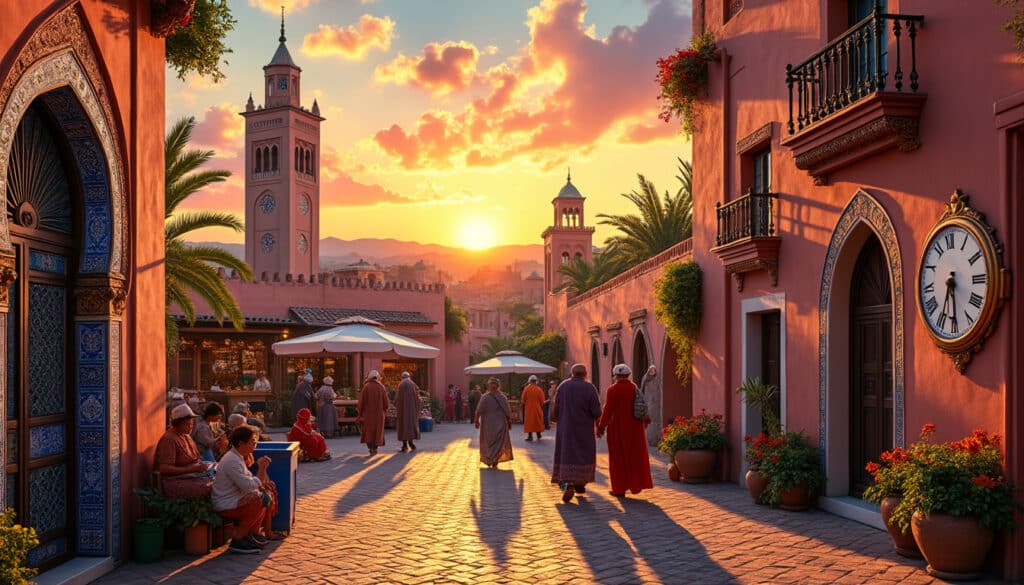
Time and time zone in Marrakesh
Marrakesh, a vibrant blend of history and culture, is a destination that attracts countless travelers every year. Whether you’re planning to experience the labyrinthine souks or explore its majestic palaces, understanding Marrakesh’s local time and timezone is essential for making…

Unusual facts and social issues in Marrakesh
Marrakesh, the captivating “Red City” of Morocco, is not only renowned for its vibrant souks and stunning architecture, but also for its unique blend of cultural and social dynamics that make it a hub of intrigue and diversity. Known for…

What does Marrakesh look, smell, feel like?
Known as the “Red City,” Marrakesh captivates all who visit with its sensory tapestry, created by the intertwining of sights, sounds, smells, flavors, and textures. A city known for its vivid colors, historical richness, and cultural diversity, Marrakesh draws explorers,…



